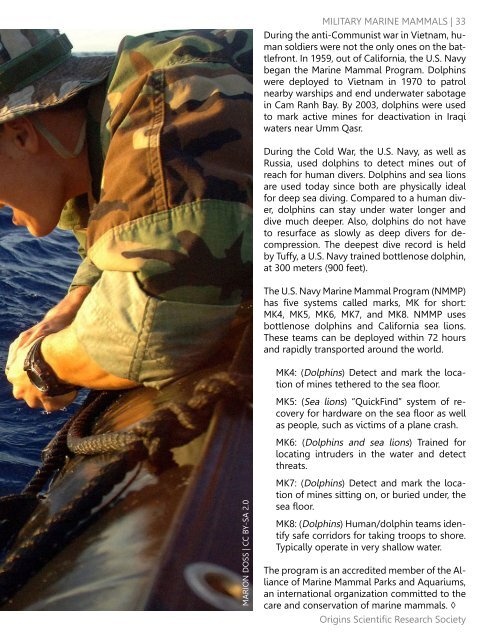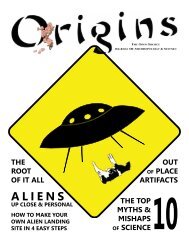Issue 10: Tech from the Military
Exploring how the military shaped the technology many of us depend on or simply desire to use on a daily basis.
Exploring how the military shaped the technology many of us depend on or simply desire to use on a daily basis.
Create successful ePaper yourself
Turn your PDF publications into a flip-book with our unique Google optimized e-Paper software.
MILITARY MARINE MAMMALS | 33<br />
During <strong>the</strong> anti-Communist war in Vietnam, human<br />
soldiers were not <strong>the</strong> only ones on <strong>the</strong> battlefront.<br />
In 1959, out of California, <strong>the</strong> U.S. Navy<br />
began <strong>the</strong> Marine Mammal Program. Dolphins<br />
were deployed to Vietnam in 1970 to patrol<br />
nearby warships and end underwater sabotage<br />
in Cam Ranh Bay. By 2003, dolphins were used<br />
to mark active mines for deactivation in Iraqi<br />
waters near Umm Qasr.<br />
During <strong>the</strong> Cold War, <strong>the</strong> U.S. Navy, as well as<br />
Russia, used dolphins to detect mines out of<br />
reach for human divers. Dolphins and sea lions<br />
are used today since both are physically ideal<br />
for deep sea diving. Compared to a human diver,<br />
dolphins can stay under water longer and<br />
dive much deeper. Also, dolphins do not have<br />
to resurface as slowly as deep divers for decompression.<br />
The deepest dive record is held<br />
by Tuffy, a U.S. Navy trained bottlenose dolphin,<br />
at 300 meters (900 feet).<br />
The U.S. Navy Marine Mammal Program (NMMP)<br />
has five systems called marks, MK for short:<br />
MK4, MK5, MK6, MK7, and MK8. NMMP uses<br />
bottlenose dolphins and California sea lions.<br />
These teams can be deployed within 72 hours<br />
and rapidly transported around <strong>the</strong> world.<br />
MK4: (Dolphins) Detect and mark <strong>the</strong> location<br />
of mines te<strong>the</strong>red to <strong>the</strong> sea floor.<br />
MK5: (Sea lions) “QuickFind” system of recovery<br />
for hardware on <strong>the</strong> sea floor as well<br />
as people, such as victims of a plane crash.<br />
MK6: (Dolphins and sea lions) Trained for<br />
locating intruders in <strong>the</strong> water and detect<br />
threats.<br />
MARION DOSS | CC BY-SA 2.0<br />
MK7: (Dolphins) Detect and mark <strong>the</strong> location<br />
of mines sitting on, or buried under, <strong>the</strong><br />
sea floor.<br />
MK8: (Dolphins) Human/dolphin teams identify<br />
safe corridors for taking troops to shore.<br />
Typically operate in very shallow water.<br />
The program is an accredited member of <strong>the</strong> Alliance<br />
of Marine Mammal Parks and Aquariums,<br />
an international organization committed to <strong>the</strong><br />
care and conservation of marine mammals. ◊<br />
Origins Scientific Research Society


















